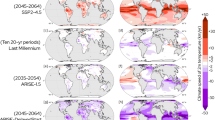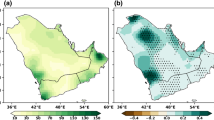Abstract
On 15 January 2022, the Hunga Tonga–Hunga Ha’apai (HTHH) eruption injected 146 MtH2O and 0.42 MtSO2 into the stratosphere. This large water vapour perturbation means that HTHH will probably increase the net radiative forcing, unusual for a large volcanic eruption, increasing the chance of the global surface temperature anomaly temporarily exceeding 1.5 °C over the coming decade. Here we estimate the radiative response to the HTHH eruption and derive the increased risk that the global mean surface temperature anomaly shortly exceeds 1.5 °C following the eruption. We show that HTHH has a tangible impact of the chance of imminent 1.5 °C exceedance (increasing the chance of at least one of the next 5 years exceeding 1.5 °C by 7%), but the level of climate policy ambition, particularly the mitigation of short-lived climate pollutants, dominates the 1.5 °C exceedance outlook over decadal timescales.
This is a preview of subscription content, access via your institution
Access options
Access Nature and 54 other Nature Portfolio journals
Get Nature+, our best-value online-access subscription
$29.99 / 30 days
cancel any time
Subscribe to this journal
Receive 12 print issues and online access
$209.00 per year
only $17.42 per issue
Buy this article
- Purchase on Springer Link
- Instant access to full article PDF
Prices may be subject to local taxes which are calculated during checkout

Similar content being viewed by others
Data availability
The ERA5 data required to estimate the radiative perturbation caused by the HTHH eruption are available at https://cds.climate.copernicus.eu/cdsapp#!/dataset/reanalysis-era5-pressure-levels-monthly-means?tab=overview23, including atmospheric temperature, specific humidity (water vapour MMR), ozone MMR, cloud fraction, cloud liquid and ice water content, evaluated on pressure levels. ERA5 surface albedo and surface temperature variables are available at https://cds.climate.copernicus.eu/cdsapp#!/dataset/reanalysis-era5-single-levels-monthly-means?tab=form23. The SSP ERF time series used to estimate the global temperature response are available at https://doi.org/10.5281/zenodo.5705391 (ref. 28).
Code availability
The FaIR v.2.0 simple climate model used to estimate the global temperature response is available at https://doi.org/10.5281/zenodo.4683173 (ref. 20). The SOCRATES radiative transfer model is available at https://code.metoffice.gov.uk/trac/socrates/wiki15, with instructions on how to access in https://homepages.see.leeds.ac.uk/~lecsjed/winscpuse/socrates_userguide.pdf. Figure production code is available from https://doi.org/10.5281/zenodo.7319240 (ref. 28).
References
Matoza, R. S. et al. Atmospheric waves and global seismoacoustic observations of the January 2022 Hunga eruption, Tonga. Science 377, 95–100 (2022).
Global Sulfur Dioxide Monitoring Home Page (NASA, 2022); https://so2.gsfc.nasa.gov/
Hunga Tonga–Hunga Ha’apai (Smithsonian Institution, 2022); https://volcano.si.edu/volcano.cfm?vn=243040
León, J. A. P. Monitoring the Atmospheric Impacts of the Hunga-Tonga Eruption (ECMWF, 2022); https://www.ecmwf.int/en/newsletter/171/news/monitoring-atmospheric-impacts-hunga-tonga-eruption
Millán, L. et al. The Hunga Tonga–Hunga Ha’apai hydration of the stratosphere. Geophys. Res. Lett. 49, e2022GL099381 (2022).
Guo, S., Bluth, G., Rose, W., Watson, M. & Prata, A. Re-evaluation of SO2 release of the 15 June 1991 Pinatubo eruption using ultraviolet and infrared satellite sensors. Geochem. Geophys. Geosys. https://doi.org/10.1029/2003GC000654 (2004).
Sellitto, P. et al. The unexpected radiative impact of the Hunga Tonga eruption of January 15th, 2022. Commun. Earth. Environ. 3, 288 (2022).
Zhang, H. et al. Potential impact of Tonga volcano eruption on global mean surface air temperature. J. Meteorol. Res. 36, 1–5 (2022).
Zhu, Y. et al. Perturbations in stratospheric aerosol evolution due to the water-rich plume of the 2022 Hunga-Tonga eruption. Commun. Earth Environ. 3, 248 (2022).
WMO Update: 50:50 Chance of Global Temperature Temporarily Reaching 1.5 °C Threshold in Next Five Years (WMO, 2022); https://public.wmo.int/en/media/press-release/wmo-update-5050-chance-of-global-temperature-temporarily-reaching-15%C2%B0c-threshold
Hermanson, L. et al. WMO global annual to decadal climate update: a prediction for 2021–2025. Bull. Am. Meteorol. Soc. 103, E1117–E1129 (2022).
Meinshausen, M. et al. The shared socio-economic pathway (SSP) greenhouse gas concentrations and their extensions to 2500. Geosci. Model Dev. 13, 3571–3605 (2020).
Boer, G. J. et al. The Decadal Climate Prediction Project (DCPP) contribution to CMIP6. Geosci. Model Dev. 9, 3751–3777 (2016).
Edwards, J. M. & Slingo, A. Studies with a flexible new radiation code. I: Choosing a configuration for a large-scale model. Q. J. R. Meteorol. Soc. 122, 689–719 (1996).
Manners, J., Edwards, J. M., Hill, P. & Thelen, J.-C. SOCRATES Technical Guide Suite Of Community Radiative Transfer Codes Based on Edwards and Slingo (Univ. Leeds, 2017).
Hersbach, H. et al. The ERA5 global reanalysis. Q. J. R. Meteorol. Soc. 146, 1999–2049 (2020).
Zuo, M. et al. Volcanoes and climate: sizing up the impact of the recent Hunga Tonga–Hunga Ha’apai volcanic eruption from a historical perspective. Adv. Atmos. Sci. 39, 986–1993 (2022).
Schoeberl, M. R. et al. Analysis and impact of the Hunga Tonga–Hunga Ha’apai stratospheric water vapor plume. Geophys. Res. Lett. 49, e2022GL100248 (2022).
Smith, C. et al. in Climate Change 2021: The Physical Science Basis (eds Masson-Delmotte, V. et al.) Annex III (IPCC, Cambridge Univ. Press, 2021).
Leach, N. J. et al. FaIRv2.0.0: a generalized impulse response model for climate uncertainty and future scenario exploration. Geosci. Model Dev. 14, 3007–3036 (2021).
IPCC: Summary for Policymakers. In Climate Change 2021: The Physical Science Basis (eds Masson-Delmotte, V. et al.) (Cambridge Univ. Press, 2021).
ERA5 Monthly Averaged Data on Pressure Levels From 1979 to Present (Copernicus Climate Change Service, 2019); https://doi.org/10.24381/CDS.6860A573
Copernicus Climate Change Service. ERA5 monthly averaged data on single levels from 1979 to present (2019); https://doi.org/10.24381/CDS.F17050D7
Forster, P. M. et al. Recommendations for diagnosing effective radiative forcing from climate models for CMIP6. J. Geophys. Res. 121, 460–12,475 (2016).
Hansen, J. et al. Efficacy of climate forcings. J. Geophys. Res. https://doi.org/10.1029/2005JD005776 (2005).
Myhre, G. et al. in Climate Change 2013: The Physical Science Basis (eds Stocker, T. F. et al.) Ch. 8 (IPCC, Cambridge Univ. Press, 2013).
Smith, C. et al. IPCC Working Group 1 (WG1) Sixth Assessment Report (AR6) Annex III Extended Data (2021); https://doi.org/10.5281/zenodo.5705391
Jenkins, S., Smith, C., Allen, M. & Grainger, R. Code and data for ‘Tonga eruption increases chance of temporary surface temperature anomaly above 1.5 °C’. Zenodo https://doi.org/10.5281/zenodo.7319240 (2022).
Acknowledgements
S.J. acknowledges NERC grant NE/L002612/1 and support from the European Space Agency’s Climate Change Initiative. S.J. and M.A. acknowledge funding from the European Union’s Horizon 2020 research programme with grant agreement no. 821205 (FORCeS). R.G. acknowledges support of the National Centre for Earth Observation, contract no. PR140015. C.S. acknowledges the NERC/IIASA collaborative research fellowship scheme with grant no. NE/T009381/1.
Author information
Authors and Affiliations
Contributions
S.J., M.A. and R.G. designed the study. C.S. ran the SOCRATES offline radiative transfer calculations. S.J. computed the temperature response with FaIR v.2.0, analysed the results and produced the figure. All authors contributed to writing the manuscript.
Corresponding author
Ethics declarations
Competing interests
The authors declare no competing interests.
Peer review
Peer review information
Nature Climate Change thanks Simone Tilmes, Daniele Visioni and the other, anonymous, reviewer(s) for their contribution to the peer review of this work.
Additional information
Publisher’s note Springer Nature remains neutral with regard to jurisdictional claims in published maps and institutional affiliations.
Supplementary information
Supplementary Information
Supplementary Figs. 1 and 2.
Rights and permissions
Springer Nature or its licensor (e.g. a society or other partner) holds exclusive rights to this article under a publishing agreement with the author(s) or other rightsholder(s); author self-archiving of the accepted manuscript version of this article is solely governed by the terms of such publishing agreement and applicable law.
About this article
Cite this article
Jenkins, S., Smith, C., Allen, M. et al. Tonga eruption increases chance of temporary surface temperature anomaly above 1.5 °C. Nat. Clim. Chang. 13, 127–129 (2023). https://doi.org/10.1038/s41558-022-01568-2
Received:
Accepted:
Published:
Issue Date:
DOI: https://doi.org/10.1038/s41558-022-01568-2
This article is cited by
-
Human influence can explain the widespread exceptional warmth in 2023
Communications Earth & Environment (2024)



